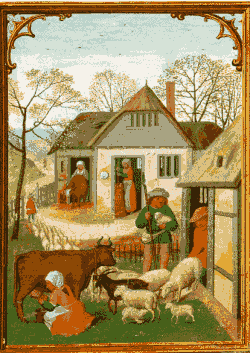Meet the Middle Ages
BackThe Village

On the plains, where the farm-land was good, people lived in villages. A village consisted of two or more farms, usually no more than ten. A few villages in Denmark had as many as twenty farms.
The farms in the village could be spread out in different ways. In some regions, for example on Öland, the farms lay in a row along the main street. The surroundings determined what the villages looked like.
The farmland and meadows were gathered in fenced-in areas. The villages had one, two or three of these sectors of land. If there were three, one was not cultivated. It lay fallow, unused, to give better crops when ploughed and cultivated again next year.
Every farm owned a strip of land within each sector. If there were many farms, the fields were normally long and narrow. The bigger the farm, the broader the strip of land. Since the fields were next to each other, the peasants had to co-operate and agree upon what to grow and when to plough, sow and harvest. They also helped each other with building and repairing the fences around the fields, to make sure the animals would not eat the crops.
The land outside the fields and farm-land was used as pasture for the cattle. One fished in the lakes.
The daily life in a village was not only about work. The villagers also shared feasts and happiness and sorrow. The children always had friends to play with.